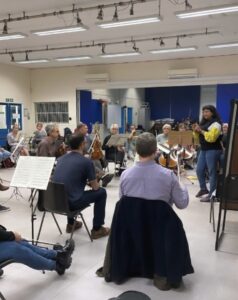
A couple of days ago, I led an improvisation session with Camden Symphony Orchestra in association with Music Patron and CSO’s music director Lev Parikian. I was the first person there which meant I got to say a gentle hello to instrumentalists as they arrived; I was greeted with real warmth…but also a slight understandable nervousness!
To start the rehearsal, Lev directed the orchestra in a run of Mendelssohn’s Hebrides Overture.
From the off, the orchestra were making a lovely sound and were clearly really passionate about the piece. I was sitting behind the horns and it was an absolute blast! (pun intended)
Then, it was my turn. I introduced myself and then asked the orchestra for what they think of when they think of the landscape as depicted in the Mendelssohn. Remote, mountainous, turbulent. Using the first couple of chords of the Mendelssohn, we improvised textures, discussing along the way how to make them relate to the words we mentioned. Very quickly, my co-composer instrumentalists were coming up with brilliant orchestration ideas, excellent assessments of how we could improve material, and when we should set a section without further changes.
Cued both by a variety of wild hand signals from me and by section leaders themselves, we quickly had a piece that was full of texture and colour that was being played with so much detail, not to mention incredibly together as an ensemble. Note lengths were matched as players listened to each other and adjusted, the balance in chords was dynamic as players used what they heard to instinctively find their next note.
There were so many great ideas AND a pretty coherent piece for something composed very quickly by so many people. How did this work? I’m not entirely sure – I’m not sure one can ever quite pin down exactly why a collaboration works. I would say there was a lot of trust in the room (and huge kudos to the players for being prepared to delve into something potentially unknown with such commitment). There was also a lot of respect for each others’ opinions and for each others’ playing. To be honest, yes, I started the conversation to begin the process but my initial ideas weren’t glittering with creativity; the magic started to happen when I asked people to respond to what we had just played, assert what might be improved, challenge them to change one thing etc.
The respect we all showed each other in the room made such a beautiful, personal piece that simply would not have existed without that exact group of people there that day and contributing the way they did. Apart from all the joy for collaboration I have taken away – a tank of joy that tends to be pretty full to eb honest – it did make me wonder: what would we all end up making if we treated our own ideas with the same respect as we treat our collaborators? Just a thought.